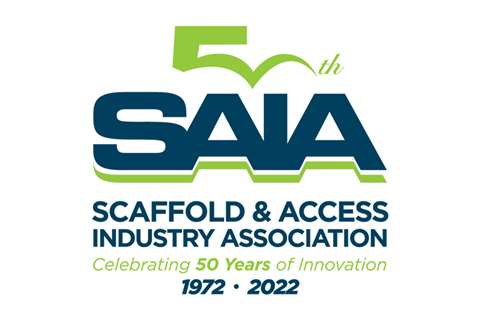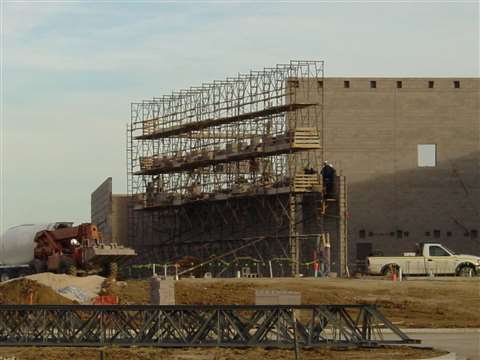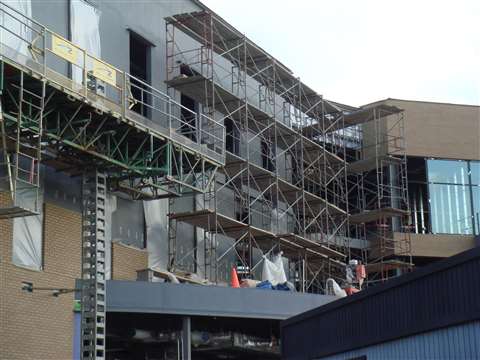SAIA’s 50-year journey
02 August 2022
If a journey of 1,000 miles begins with a single step, then can it not be said that a half-century-long journey begins with a single day?
This year marks the 50th anniversary of the Scaffold & Access Industry Association (SAIA,) an association started in California by a group of scaffold suppliers united in a common interest. Fifty years is a long time – it’s a half century, five decades, 50 years, 2,600 weeks, 18, 250 or so days… Well, you get the idea, it’s a long time.

Since that initial humble beginning, the Association has grown into an international organization representing the interests of people, companies and groups associated with the business of temporary structures. And, as can be expected, the industry and the world has evolved in ways that could not have been predicted by even the best of prophets, much less a scaffolder.
Origins
The nascent U.S. federal Occupational Safety & Health Administration (OSHA) was just beginning to establish itself as the enforcer of all things safety related, including in the scaffold industry, and California OSHA didn’t even exist. This doesn’t mean that prior to OSHA, there were no codes or standards dictating activities applicable to scaffolding, but rather there was no national agency with the mandatory enforcement powers that were established with the creation of OSHA. This was a big deal in 1972 since no one, neither the industry nor the government, had a clear understanding of the ramifications that were in store for the scaffold industry due to the passage of the Occupational Safety and Health Act of 1970.
 System scaffold, as seen here, was originally introduced to the market in the 1970s. (Photo: David Glabe)
System scaffold, as seen here, was originally introduced to the market in the 1970s. (Photo: David Glabe)
While the original scaffold regulations that were promulgated under the Act were a bit rough around the edges, they were based on existing regulations and voluntary codes, so the effect was less than revolutionary. But that’s not to say that there were no conflicts that needed resolution. Early on, OSHA realized that the scaffold regulations were less than desirable and consequently initiated the arduous process of developing better scaffold standards.
The SAIA was a major participant in the process along with the Scaffold, Shoring, and Forming Institute (SSFI,) an organization of the scaffold manufacturers. The SAIA represented the interests of its members and was instrumental in providing valuable practical input that is reflected in the current regulations. Without the SAIA and the significant input from its members, the OSHA scaffold regulations would have been much different.
In 1972, in the U.S., tubular welded frame scaffold was the predominate supported scaffold product while tube and coupler scaffold was used but primarily in industrial settings. Many suspended scaffold users were still hanging by manilla ropes. The industry was about to change though as new products were introduced into the North American market.
System Scaffold, first introduced in the U.S. in the ‘70s, quickly became the scaffold to use in power plants and refineries. Mobile elevating work platforms (MEWPs,) and more specifically, boom-supported elevating work platforms (boom lifts) and self-propelled elevating aerial platforms (scissor lifts,) hit the scaffold market at the same time. Mast climbers saw a substantial increase in use as the century came to a close; in fact, as the 21st century arrived, mechanized equipment increased in usage. However, the lowly tubular welded frame scaffold is still being used in multiple different ways on a daily basis.
 Tubular welded frame scaffold is still being used in multiple ways on jobs today. (Photo: David Glabe)
Tubular welded frame scaffold is still being used in multiple ways on jobs today. (Photo: David Glabe)
Technology’s introduction
Computerization substantially impacted all aspects of the scaffold industry in the last 50 years. From billing to design, the computer has simplified many tasks and provided increased efficiency in billing, inventory control, project management and scaffold design. Where adding machines and slide rules once ruled, now computer programs and computer aided drafting performs the dreary tasks of everyday scaffold administration. The internet wasn’t even a dream in 1972.
Manufacturing has seen a huge change over the last 50 years. Efficiencies in transportation have made global manufacturing possible with offshore companies producing the majority of scaffold products versus 50 years ago.
The Association has been a leader in the development of safety codes and other related information pertaining to the temporary structure industry. After the OSHA scaffold regulations were revised in 1996, the SAIA decided that it should develop training programs for individuals who worked with scaffolding and so it was that the SAIA partnered with the Southern Alberta Institute of Technology to begin the process. Since then, training has become an essential function of the SAIA, developing programs and training instructors.
However, it is the SAIA members who make the difference: Many members volunteer their time, expertise and experience to further the Association’s goals, originally established under the leadership of the first president, Gerald F. Towse.
Subsequent presidents have continued that legacy. The management team has been instrumental in the operation of the Association, beginning with the influential and energetic Victor Saleeby in 1972. The present management team continues that legacy, efficiently assisting the Association’s elected officers in their duties and providing invaluable support for the members.
Engineering advances
Given that scaffolds are structures, in many ways similar to any other building, engineering has played an important role in the design, research, testing and manufacturing of scaffold products. However, engineers have historically been operating “behind the scenes,” so to speak. While complicated scaffold structures have always included specific engineering design, most scaffold installations traditionally have been designed by qualified persons, based on their experience in the field.
 Mast climbers became extremely popular for work at height during the turn of the century. (Photo: David Glabe)
Mast climbers became extremely popular for work at height during the turn of the century. (Photo: David Glabe)
The requirement for Professional Engineers to be involved in the design process of scaffolding has been increasing since the advent of the Association and there is no reason to believe it will not continue to be required, particularly since scaffolding is being used in increasingly innovative ways.
Speaking of engineering, comes now a milestone event in the history of the Association. SAIA members have increased the Association’s prestige by electing a Professional Engineer as president. President-Elect, Tracy Dutting-Kane, P.E., is the first Association president who is a Professional Engineer, and she brings with her a wealth of expertise and experience in the scaffold industry, having started in the business in 1996.
With this strong background, Dutting-Kane, P.E. has stated that she will focus on training and outreach during her term. While a long time coming, it is a finishing touch ending the first 50 years, and a foundation for the next 50 years.
What will the next 50 years bring to the Association and the scaffold industry? It is easy to predict that, if the past 50 years are any indication, the next 50 years are unpredictable.
 From left to right: Outgoing SAIA President Michael Paladino; President-Elect Tracy Dutting-Kane, P.E.; Immediate Past President James Holcomb. (Photo: SAIA)
From left to right: Outgoing SAIA President Michael Paladino; President-Elect Tracy Dutting-Kane, P.E.; Immediate Past President James Holcomb. (Photo: SAIA)
STAY CONNECTED



Receive the information you need when you need it through our world-leading magazines, newsletters and daily briefings.
CONNECT WITH THE TEAM





